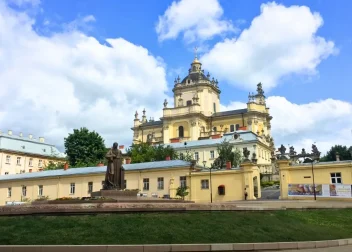Lviv Memorial Museum
This is a 127-year-old prison that witnessed the horrors of the Polish, Nazi, and Soviet regimes, with cells where torture took place.
The names of the cells are written in English as well. The “Condemned Cell” was where prisoners waiting for execution were kept, as the name suggests.

On the second floor of the prison, we met an elderly lady who was very informative. Thanks to her, we learned that the paintings on the walls were made by a female prisoner, though even without knowing this, the images clearly reflect pain and chaos. Another thing hanging on the wall is a long list of names, with ticks next to the names of the dead or killed. From 1941 onwards, mass executions occurred. When the Soviet-German war started, 4,000 people were killed in 6 days, and 1,681 of them were in this prison. In addition to Ukrainians, Poles and Jews were also among the victims. Many of the dead were buried in Lychakiv Cemetery. During the German occupation, mass killings continued. In the Lviv region, 700,000 people were killed, including 133,000 Jews.
Prisoners lived in unhygienic conditions; not only was water not provided to the cells, but they were allowed to bathe only once every 8 months. As a result, the Typhus virus spread throughout the prison. Those who fell ill were killed, while the healthy ones were sent to concentration camps.
During the Soviet era, torture was not limited to interrogations but became routine. To break the prisoners and extract information, the lights and doors were left open to prevent them from sleeping.
In one cell, there are small tools like pickaxes that prisoners tried to smuggle in to escape. Another is displayed as the inspector’s office. One of the most moving rooms for me was the one where photos of prisoners were displayed, along with writings underneath describing what they went through. A female prisoner, upon being told she could leave after 10 years and receiving her belongings, said her entire youth had been wasted there. A male prisoner said he prayed to God for a fair death during his torture, while another expressed happiness that he would die in a free country. As I left this room, my eyes filled with tears, and I had goosebumps – feelings similar to those I had at Dachau. What’s worse is that war doesn’t stop; despite all this painful history, war breaks out somewhere else for another reason. Due to the recent war with Russia, the items from the Soviet era in the cell have been taken by Russia, and the museum was even closed for a while. According to the taxi driver, America was provoking Ukraine to make an atomic bomb, and Russia didn’t want such a threat so close to them.
Normally, visitors aren’t taken to the third floor of the museum, but the lady liked us and took us up there. This floor housed the elderly because both the cells and bathrooms were in better condition. However, there was also a soundproofed torture room with walls padded to prevent noise, a true tragedy.
Entrance is free.
Address: Stepana Bandery Street, 1 (The entrance is on Karla Briullova Street; on the maps.me map, it’s listed as the Nazi-Soviet Museum.)

